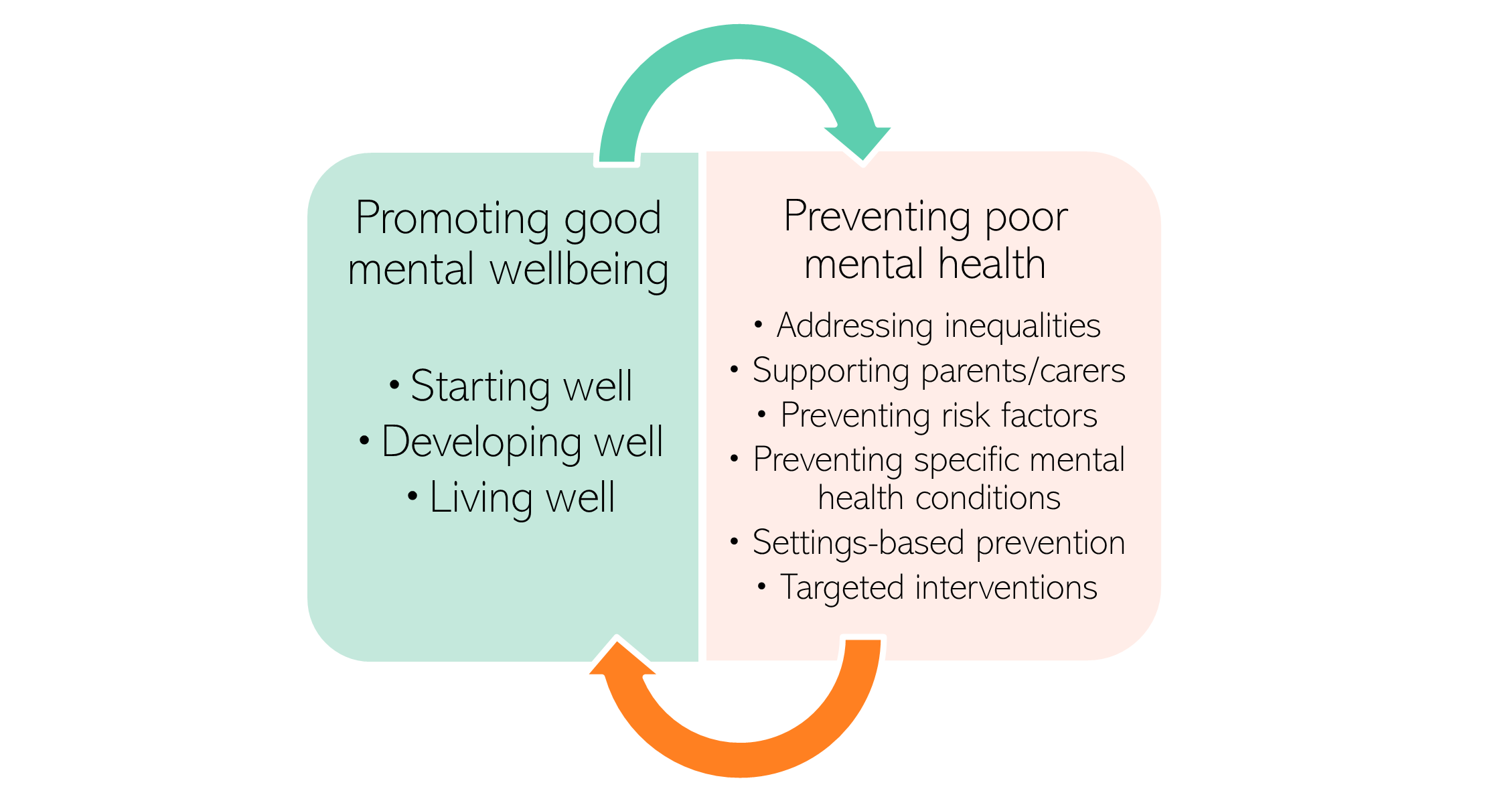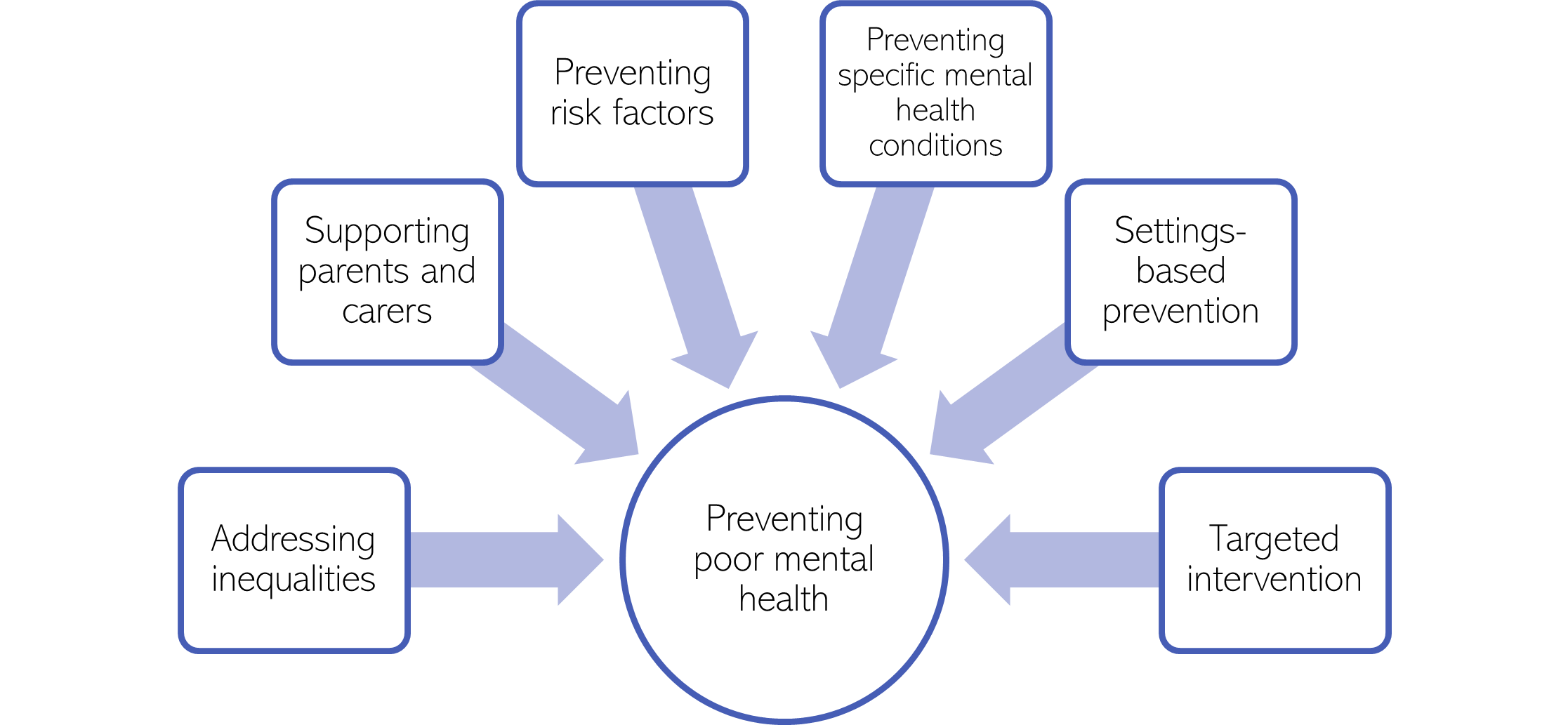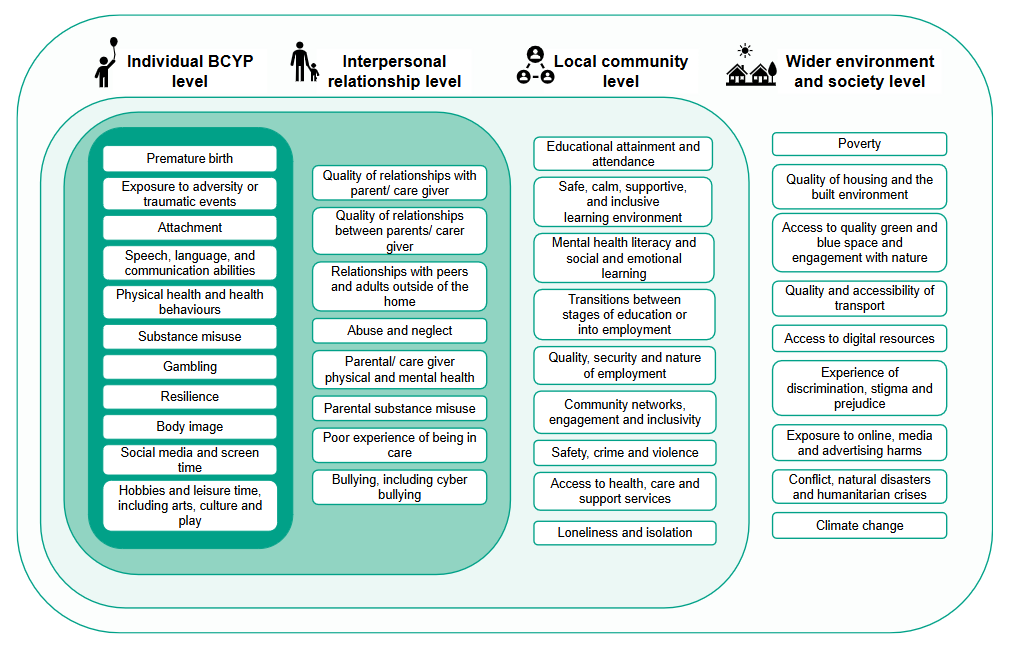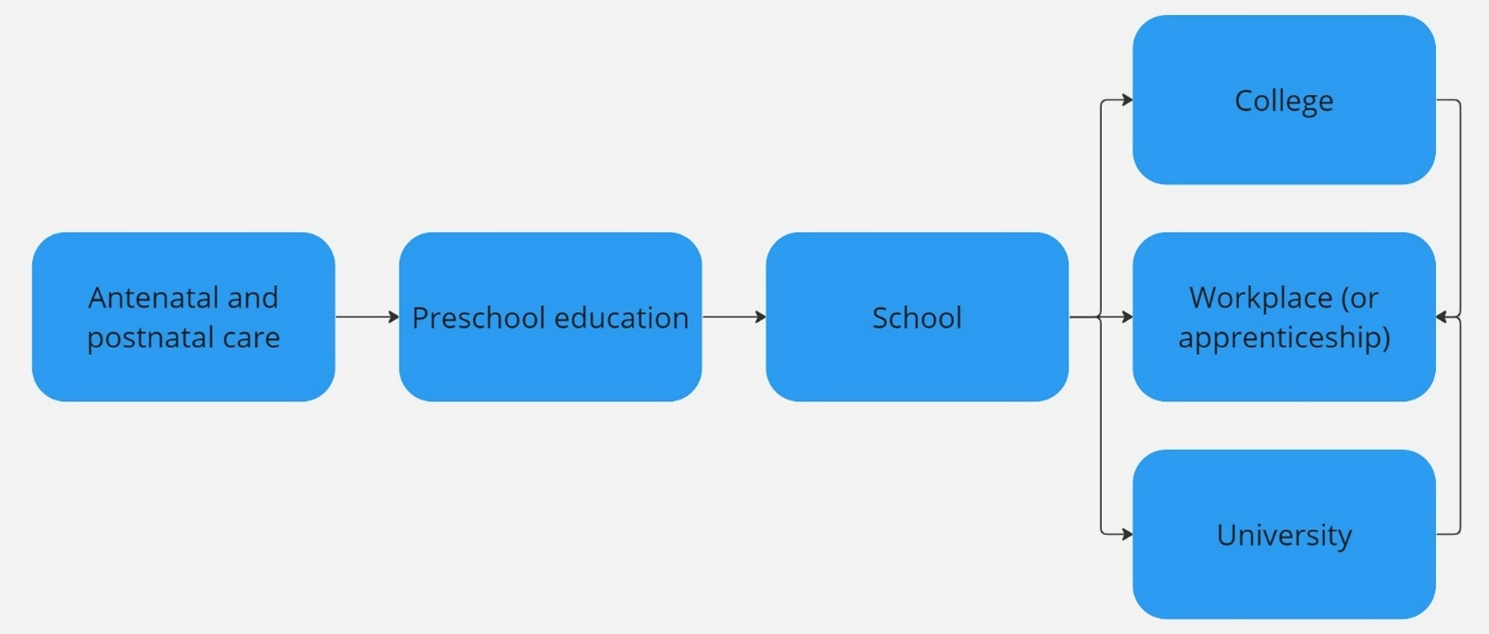Evidence base for prevention
This section focuses on the evidence around preventing the development of mental health conditions. Preventing difficulties developing into diagnosable mental health conditions can reduce the impact of poor mental health on children and young people and limit the costs of treatment (Clarke et al., 2021).
- Promoting children and young people’s mental health and wellbeing will have a positive impact on their cognitive development, learning, physical health, and social and economic prospects in adulthood (Public Health England, 2019b).
- Contrastingly, poor mental wellbeing at this age increases the likelihood in later life of mental health problems, harmful drug and alcohol use, and involvement in criminal activity (Public Health England, 2019b).
- Upstream interventions for mental health are the most cost-effective approach and have been shown to reduce pressure across the healthcare system, from GPs to accident and emergency departments (Children and Young People’s Mental Health Coalition & Centre for Mental Health, 2022). Lost opportunities for intervention in early childhood have been estimated to cost England £16.1 billion in 2018/19 alone (Centre for Early Childhood, 2021).
- Key elements of universal mental health programmes aimed at children and young adults are psychoeducation, problem-solving, communication skills and insight building; all of which are likely to be important for interpersonal development and good mental health (Boustani et al., 2020).
- Local people (children and young people, parents and professionals) in the East of England highlight that prevention of mental health difficulties and the promotion of good mental health as a top priority for mental health services (Howarth et al., 2019).
This subsection of the needs assessment is based on Campion’s 2012 review of public mental health (Campion, 2019).
Figure 5: Evidence-base for preventing poor mental health and promoting good mental wellbeing. Adapted from: (Campion, 2019)
The following factors are important for preventing poor mental health: addressing inequalities, supporting parents and carers, preventing risk factors, preventing specific mental health conditions, settings-based prevention and targeted intervention.
Figure 6: Six factors important for preventing poor mental health. Adapted from: (Campion, 2019)
There is also a page summarising evidence around the prevention of abuse, which can have significant impacts on children and young people’s development, health and wellbeing.
Overview of prevention
The diagram below highlights the range of modifiable factors that influence children and young people’s mental health, as highlighted by the Department of Health and Social Care.
Figure 1: A framework of modifiable factors to guide promotion and prevention for babies, children and young people’s mental health. Image source: Department of Health and Social Care
Following a similar framework, 32 approaches to promoting good mental health in children and young people are listed below. Note that this is not an exhaustive list and the strength of evidence for these interventions varies.
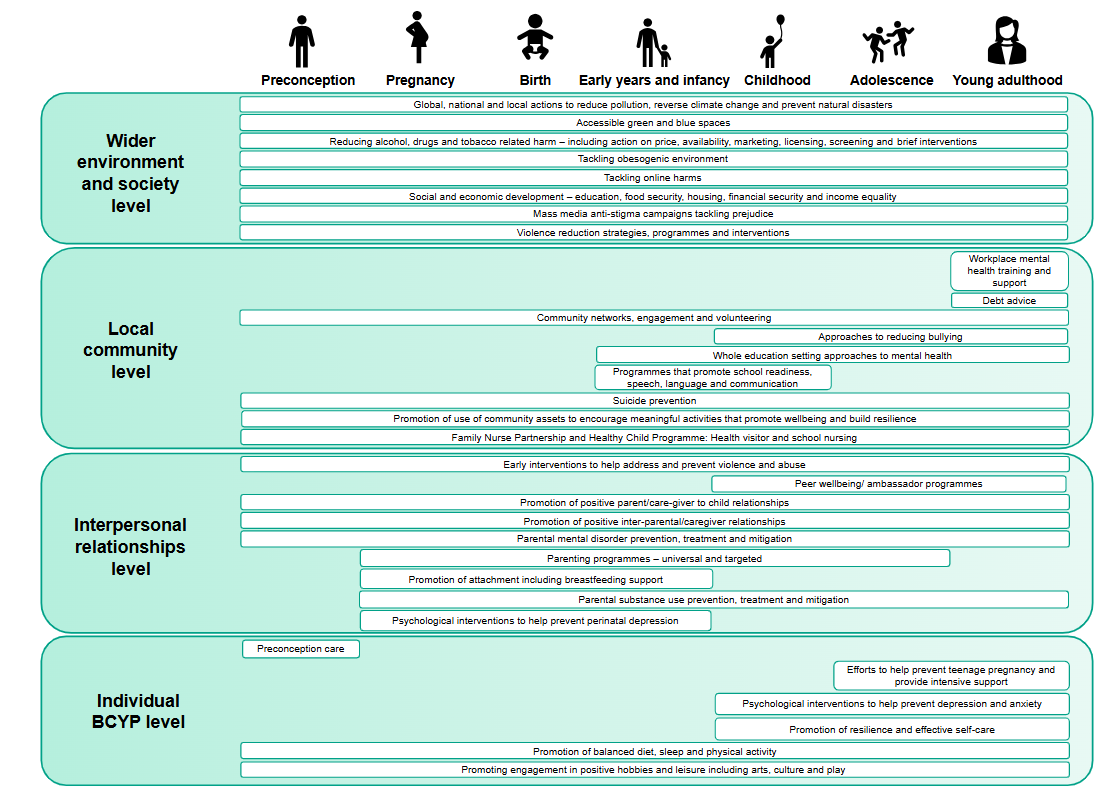 Figure 2: Examples of approaches to promote good mental health, and prevent poor mental health, in children and young people. Image source: Department of Health and Social Care
Figure 2: Examples of approaches to promote good mental health, and prevent poor mental health, in children and young people. Image source: Department of Health and Social Care
Addressing inequalities
The evidence base on reducing mental health inequalities for children and young people is covered in chapter 2 of this needs assessment.
Supporting parents and carers
Children’s relationship with their parents or carers has a major impact on their social and emotional wellbeing. Loving and trusting relationships, connection and feeling supported are all associated with positive wellbeing; whilst parental mental health conditions, family breakup and hostility are associated with negative wellbeing (Public Health England, 2019b).
- The ‘foundations of good mental health are put in place before a child is even born’ (Children’s Commissioner, 2022). Evidence-based interventions to promote good mental health during this time period include minimising alcohol consumption during pregnancy (Gilinsky et al., 2011), and interventions improving the outcomes of parental mental health conditions (National Institute for Health Care Excellence, 2016). More detail is given on this in the chapter on perinatal mental health.
- Parenting programmes can help to improve parental mental health and child emotional outcomes; and prevent children from developing mental health conditions, including anxiety disorders (Campion, 2019; Yap et al., 2016)
- Meta-analyses suggest that parent-led and brief parenting interventions (lasting under 8 sessions) can be effective for children who have, or are at risk of having behavioural problems (Tarver et al., 2014; Tully & Hunt, 2016). These approaches may be useful when expanding the reach of parenting interventions.
- The Golden Threads project is carrying out a systematic review of interventions that promote young children’s mental health or related parenting outcomes. This project will identify common elements of these interventions, as well as important delivery and implementation factors. Findings will be published in August 2024.
- A review of ‘what works to enhance inter-parental relationships and improve outcomes for children’ identified many international interventions with had positive impacts on relationships between parents and child outcomes. It highlighted the importance of targeting both parent-child and couple relationships for sustaining positive outcomes for children in cases on ongoing parental conflict (G. T. (Gordon T. Harold et al., 2016).
A national report found that parents describe a range of benefits after attending parenting programmes. This included improvements in behaviour for children with severe behavioural problems, reductions in family stress levels and better parental mental health; although maintaining this progress could be challenging. Some children and parents with multiple and complex needs reported needing ongoing support (Khan, 2018).
What is the local picture?
- Parenting programmes are offered across Cambridgeshire and Peterborough and cover a host of topics such as Stepping Stones, a parenting course for parents with children who have SEND or ADHD, and courses for parents raising teenagers (Hedges et al., 2019).
- There is a range of universal and voluntary and community sector services supporting new and expectant parents, including the Healthy Child programme and Family Hubs.
Preventing risk factors
Almost a third of all mental health conditions in adulthood are directly connected to an adverse childhood experience (ACE) (Kessler et al., 2010). Preventing adversity is therefore key to improving population mental health. Whilst there is some research about promoting resilience/preventing mental ill health in people who have survived childhood abuse (secondary prevention), fewer academic studies have explored interventions to prevent abuse from occurring (primary prevention) (Austin et al., 2020).
- Prevention of child abuse falls under child protection, which is covered by a range of legislation and NICE guidelines (NICE, 2017a). These guidelines highlight the importance of safeguarding vulnerable children and early interventions to address child abuse and maltreatment (NICE, 2017a).
- There are NICE guidelines on identifying, preventing and reducing domestic violence and abuse, including in young people (National Institute for Health and Care Excellence, 2014).
- Evidence-based approaches to reducing child maltreatment and abuse include education for new and expectant parents, home visiting programmes, and parent training programmes (Campion, 2019).
- School-based programmes can reduce bullying, violence and students’ knowledge about sexual abuse prevention (Campion, 2019). All state schools in the UK are required to have a policy for bullying prevention.
- The World Health Organisation identified seven strategies for ending violence against children in their INSPIRE report (World Health Organization, 2016).
- Evidence also shows effective approaches to mitigating the impact of adversity in children and young people, as detailed in a report by the Department of Health and Social Care Reviews Facility (Lester et al., 2019).
- Some evidence suggests that psychological interventions (cognitive behavioural therapy (CBT) and eye movement desensitisation and reprocessing (EMDR)) can prevent and treat post-traumatic stress disorder (PTSD) and lead to a short-term reduction in symptoms in children and young people who have undergone a traumatic event (Gillies et al., 2016).
- Supportive and trusted relationships with adults are particularly important for children who have experienced adversity. The health impact of experiencing 4 or more ACEs is mitigated by having continuous support from an adult figure in childhood (Bellis et al., 2017).
- A review of carried out in 2020 summarised risk and protective factors associated with child abuse, using the socioecological model as a framework (Austin et al., 2020). Protective factors included:
-
- Individual: Social competence; adaptive functioning; self-esteem
- Interpersonal: Supportive, nurturing parental relationships; parents having social and emotional support from family and friends
- Community: Neighbourhood social cohesion and control; availability of health, social, and education services
- Societal: Earned Income Tax Credits; increases in minimum wage
-
Other important risk factors for poor mental health include physical activity, which a meta-analysis has shown is linked to improvements in children’s mental health (Ahn & Fedewa, 2011). Physical activity interventions in children and young people (aged 10 to 21) have small to moderate impacts on externalising and internalising problems (Spruit et al., 2016).
What is the local picture?
- Children’s social care services in Cambridgeshire and Peterborough are responsible for safeguarding children and child protection
- Early Help is a council run service offering support to families that need additional support but that do not reach social care thresholds. Service user data is included in the Children and Young People’s Mental Health Strategy (Cambridgeshire and Peterborough Integrated Care System, 2022d).
Preventing specific mental health conditions
Some interventions have been shown to help prevent specific mental health conditions in children and young people, including anxiety and depression, conduct disorders, eating disorders, and self-harm and suicide (Campion, 2019).
- Anxiety and depression: Universal interventions (Ahlen et al., 2015), including school-based approaches (Durlak et al., 2011); psychological interventions (Stockings et al., 2016); and early intervention for sub-threshold depression (Campion, 2019).
- The Changing Minds, Changing Lives report brings together evidence-based approaches to preventing the development of depression in children and young people, supporting their recovery and helping them to maintain this. They also provide evidence around building depression-resilient communities
- Conduct disorder: School-based universal interventions (Durlak et al., 2011)
- Eating disorders: Universal prevention, including media literacy, CBT and psychoeducation (Watson et al., 2016)
- Self-harm and suicide: The evidence base around prevention of suicide and self-harm is covered in the Cambridgeshire and Peterborough Suicide Prevention Strategy.
The National Institute for Health and Care Excellence (NICE) provides the evidence base for the treatment of every mental health condition. The Anna Freud Centre has also summarised information about treatment options.
What is the local picture?
- Mental Health Support Teams (MHSTs) and the Children’s Wellbeing Practitioner (CWP) team provide evidence-based early interventions for mild to moderate mental health need in children and young people in schools.
- The Body Project, an evidence-based eating disorder prevention programme, has been funded in Cambridgeshire and Peterborough. The Personalised Eating Disorder service (PEDs) is also running training to equip people with tools to recognise and respond to those at risk of developing eating disorders.
- The Cambridgeshire and Peterborough Suicide Prevention Strategy covers local work preventing suicide and self-harm.
Settings-based prevention
Interventions can be targeted at specific settings, from antenatal and postnatal care to the workplace (Campion, 2019).
Figure 7: Settings for interventions to prevent poor mental health across the life-course
Examples of interventions include:
- Antenatal and postnatal care settings can improve the coverage of smoking cessation programmes and interventions to reduce substance use during pregnancy. They can also promote the prevention and treatment of parental mental health conditions (Campion, 2019).
- Preschool education programmes focusing on social and emotional development have been shown to reduce child externalising problems (Schindler et al., 2015).
- School factors explain a small but significant proportion of the varying mental health of young people (Ford et al., 2021). School-based programmes have been shown to reduce violence, bulling and help to prevent domestic violence.
- University-based interventions can be effective in reducing anxiety, depression and psychological distress in students who are showing early signs of poor mental health (Conley et al., 2017).
- Workplaces can be designed to promote good mental health, with examples including flexible working policies and supporting workers’ recovery or management of mental health conditions (Harvey et al., 2014). Unemployment interventions, including those focused on job-hunting skills, personal development and maintaining paid work, have been shown to reduce mental distress and increase employment (Harvey et al., 2014).
What is the local picture?
- Chapter 3 of the needs assessment covers the services providing support for families during the perinatal period (from pregnancy to two years after birth).
- There is a range of services providing mental health support in schools .
Targeted interventions
Interventions can be targeted at children and young people at higher risk of developing mental health conditions.
- Children in care: NICE recommends that preventative interventions should be offered to care experienced young people, based on need (NICE, 2022)
- LGBTQ+ children and young people: Whole-school approaches that address the ‘marginalisation, silence and victimisation’ faced by LGBTQ+ students (Mcdermott et al., 2022); and social support systems (including school professionals, school climate and families) (Leung et al., 2022). Pupils in schools with strong positive messaging about being LGBTQ+ feel safer at school than those without – regardless of if they are LGBTQ+ themselves (Just Like Us, 2021)
- Refugees: There is some evidence that individual and group psychotherapeutic interventions, as well as art-based interventions, can help to reduce symptoms of poor mental health in teenage refugees (Hettich et al., 2020)
What is the local picture?
- Mental Health Clinicians are embedded in social care teams in Cambridgeshire to work with children and families in the social care system with mental health disorders. This is to be slimmed down and in part replaced with fewer mental health nurses working only with adults (the Herefordshire model) (Hedges et al., 2019).
- The Kite Trust supports the wellbeing of LGBTQ+ young people (aged 30 or under) in Cambridgeshire and Peterborough.
- Barnardo’s offers a range of support to young people leaving care, LGBTQ+ young people, and children seeking asylum.
Additional resources
Other relevant reports about the prevention of poor mental health and promotion of good wellbeing include:
- NHS East of England has recently produced a report on ‘Children and Young People’s Mental Health: Early Intervention and Prevention Programmes’, a review on universal and targeted interventions and practical considerations for these interventions
- Interventions for Young Children’s Mental Health: A Review of Reviews
- Digital approaches may be useful in preventing poor mental health. A more detailed review of digital interventions for children and young people’s mental health is currently being undertaken by the NHS East of England team and will be available to access in Summer 2023.
- The World Health Organisation’s Helping Adolescents Thrive toolkit suggests strategies and implementation approaches to promote and protect children and young people’s (aged 10 – 19) mental health (World Health Organisation & Unicef, 2021).
- Public Health England’s framework identified six principles to shape thinking about young people’s health and wellbeing, and placed relationships at the centre (Public Health England, 2015).
- The Local Government Association’s report on case studies of ‘whole household’ approaches to young people’s mental health, which involve families in support (Local Government Association, 2023).
- World Health Organisation Guidelines on promotive and preventive mental health interventions for adolescents: helping adolescent thrive
- What works to enhance inter-parental relationships and improve outcomes for children
- A chance to change: delivering effective parenting programmes to transform lives
- Healthy child programme schedule of interventions guide
- NSPCC reports on Parent interventions to prevent child maltreatment: evidence summary and What professionals know, think and do to prevent child abuse – and how we can support them
- What helps to support people affected by Adverse Childhood Experiences? A review of evidence
- Public Health England guidance on Supporting public health: children, young people and families
- The Royal College of Psychiatrists summarised evidence around public mental health interventions with a strong or moderate evidence base. Interventions during the perinatal period to prevent child mental illness had the strongest evidence base. The full details are summarised on pages 6 – 10 in this report.
- Strategies for Enhancing the Implementation of Universal Mental Health Prevention Programs in Schools: A Systematic Review
- Are Physical Activity Interventions Effective in Improving Health-Related Quality of Life in Children and Adolescents? A Systematic Review and Meta-Analysis
- Interventions targeting the mental health and wellbeing of care-experienced children and young people in higher-income countries: Evidence map and systematic review
- Understanding and supporting mental health in infancy and early childhood – a toolkit to support local action in the UK
- Improving the mental health of babies, children and young people: methodology, literature and stakeholder feedback that informed the framework
- Improving the mental health of babies, children and young people: examples of government-led contributions
- The Mental Health Foundation’s report on the economic case for investing in the prevention of mental health condition highlights the strong economic evidence for prevention for school-age children.
- Centre for Mental Health Priorities for preventing mental ill health among children and young people
References
Full list of references is included at the end of this chapter.

